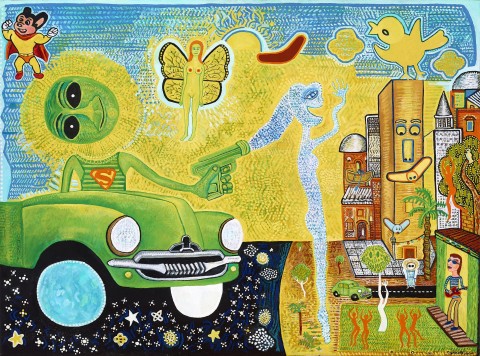HOLDEN BOOMERANG DREAMING IN SUMMER TIME, 2000
TREVOR NICKOLLS
synthetic polymer paint on canvas
91.0 x 121.5 cm
signed and dated lower right: NICKOLLS 2000
Vivien Anderson Gallery, Melbourne
The Peter and Renate Nahum Collection of Aboriginal Art, London, acquired from the above in 2009
Masterwork, Vivien Anderson Gallery, Melbourne, 11 October – 4 November 2006
Trevor Nickolls: New + Important Early Paintings & Drawings, Vivien Anderson Gallery, Melbourne, 12 May – 13 June 2009, cat. 18 (illus. in exhibition catalogue)
Family in Blue Holden, 1998, synthetic polymer paint on canvas, 121.5 x 152.5 cm in the collection of the National Gallery of Australia, Canberra
With a singular emphasis on the human condition and reflecting a continual internal struggle in his life regarding the balancing act between his indigenous and non-indigenous heritage, the art of Trevor Nickolls resonates widely today. Mesmerising and full of personal symbolism, his work was shaped by multifarious influences as diverse as the masterpieces of European art, his love of landscapes, Indigenous history and mythology, comic book characters and observations of daily urban life. However, his overarching concern was the conflict between what he saw as the alienation of urban industrialism and the symbiosis between rural indigenous life and nature; the contrasts between white and black societies.
Born to an indigenous mother from Moonta in South Australia and an English/Irish father, Nickolls began to paint at a young age and drawing became a refuge for him during difficult and unhappy times at school in Adelaide, a place where he did not fit in. His early drawings combined observations of the world around him together with caricatures, figures and cartoon heroes. He later studied at the South Australian School of Art followed by a teaching degree and post graduate studies at the Victorian College of Arts.
Holden Boomerang Dreaming in Summertime, 2000 is a typical Nickolls dreamscape, with its festival of colour, activity, juxtaposed Australian icons and both obvious and obscure meanings. The painting employs an assortment of formal elements developed early in his career and provides an insight into his world, moving between tradition and modernity, or what he called ‘dreamtime’ and ‘machinetime’.1 We have the superheroes and comic book influences of his youth, city buildings crowded together dwarfing the small Wanjina figure (dressed in western garb), a large non-indigenous rock musician playing to diminutive indigenous dancing figures and larger than life, an FJ Holden, the major focus of this work and also Nickolls’ first and most loved car. The scene is illuminated by the radiating sun and references to country, city, ancestors, night and day and a myriad of characters that heighten our ongoing examination and enjoyment of this work and its performative elements.
Trevor Nickolls exhibited nationally and internationally for over thirty years and was prominent in the emergence of an urban Indigenous art. In 1990 he was selected, together with Rover Thomas, as Australia’s representative at the Venice Biennale and in 2009 a retrospective exhibition was held at the Ian Potter Museum of Art, The University of Melbourne, touring to the Northern Territory, South Australia and regional Victoria in 2010.
1. Beier, U., Dream Time - Machine Time: The Art of Trevor Nickolls, Robert Brown and Associates, and the Aboriginal Artists Agency, Sydney, 1985, p. 14.
CRISPIN GUTTERIDGE
